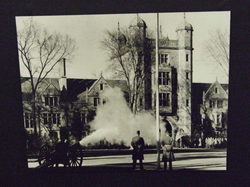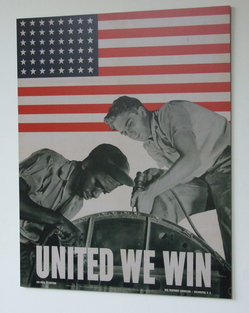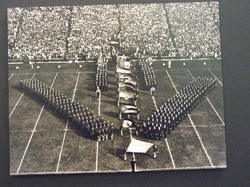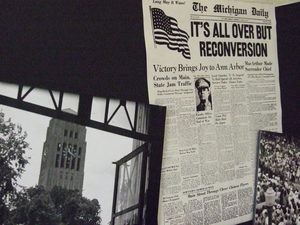During World War II, University of Michigan was an arsenal of brainpower
Cannon fire signals the beginning and end of each day.

Cannon fire marked the start of the day at the University of Michigan during World War II.
Courtesy: Harlan Hatcher Graduate Library
Soldiers march in uniform, in formation, across the Diag - and at Michigan Stadium on football Saturdays.
Professors take extended leave to fight overseas - and some never make it back home, let alone campus.
Such was life at the University of Michigan during World War II, according to a new exhibit on display this month at the Harlan Hatcher Graduate Library.
While history has been careful to note the contributions of Detroit’s “Arsenal of Democracy” to the war effort, U-M took also took a big a role in America’s wartime preparedness during the “war to end all wars.”
That story is told in “United We Win: The University of Michigan during World War II,” an exhibit in the gallery of the graduate library.
“United We Win,” which will remain in the library through early December, features a generous helping of wartime images and programming served up in dedication to the men and women who made the ultimate sacrifice during World War II.
A different world

United We Win
Courtesy: Harlan Hatcher Graduate Library
Though the United States is currently engaged in two foreign wars, one in Iraq and one in Afghanistan, the average U-M student could easily graduate without partaking in or being touched by the sacrifices of the men and women who serve in those wars.
That wasn’t the case during World War II, when every corner of campus life was transformed by the war.
In October 1942, several employees from the University of Michigan Hospital were sent to England to form the 298th General Hospital. The 298th, according to the exhibit, was one of the first hospital units to arrive on the beaches of Normandy after D-Day. During the Battle of the Bulge, the exhibit explained, the 298th treated between 600 and 700 patients a day.
In the fall of 1942, the U.S. Army uprooted its Judge Advocate General’s program from the nation’s capital and headquartered it in Ann Arbor.
The Army’s JAG program, and the aforementioned cannon, took over the Law Quad during the war. On the whole, 16 programs from the Army and Navy were taught here in Ann Arbor, and everything but the JAG program was administered and taught by U-M faculty, the exhibit notes.

Even University of Michigan football games offered awareness of the sacrifices of the military.
Courtesy: Harlan Hatcher Graduate Library
All told, 4,000 Navy and Marines, 8,000 Army men, and nearly 12,000 civilian contractors were trained at U-M during World War II - most of them by university faculty. Fifteen hundred others received Japanese language instruction on campus, an effort spearheaded by U-M Assistant Professor Joseph Yamagiwa.
And that doesn't include the thousands of faculty members, students, and staffers who took part in the war.
An honorable sacrifice
After the war was won in August 1945, the Michigan Daily campus newspaper hailed “It’s all over but reconversion,” the tough work of reacclamating veterans to life on the homefront in peacetime.
The university then shifted its efforts from training young men and women for their service to recognizing the sacrifices of those who served. Dean of Students Erich Walter wrote letters to literary giants (E.B. White), world leaders (Winston Churchill and Chiang Kai-shek) and Hollywood legends (Orson Welles) asking for their ideas in crafting an appropriate tribute.
In the end, U-M decided the best way to recognize the wartime sacrifices of Michigan men and women was to find ways to use nuclear power for the good of mankind, rather than for its destruction.

It’s all over but the tough part: reconversion
Courtesy: Harlan Hatcher Graduate Library
In 1948, the Board of Regents resolved to “create a war memorial center to explore the ways and means by which the potentialities of atomic energy may become a beneficent influence in the life of man, to be known as the Phoenix Project of the University of Michigan.”
More than five decades later - in 2004 - a university that once saw its duty as preparing men for the front lines turned its focus to keeping them off the battle field, when the Regents broadened the focus of the Phoenix Project to include “research on the development of energy policies that will promote world peace, the responsible use of the environment, and economic prosperity.”
“United We Win” will remain at the Graduate Library through Dec. 2.
WHEN AND WHERE
United We Win: The University of Michigan during World War II
Gallery room 100, Harlan Hatcher Graduate Library
8 a.m.-5 p.m., through Dec. 2
913 S. University Avenue
Third Thursday: The Maps of World War II
Thursday, Nov. 19, 4-7 p.m.
825 Harlan Hatcher Graduate Library
913 S. University Avenue
The Life and Times of Rosie the Riveter
Thursday, Nov. 19, 7 p.m.-8 p.m.
Gallery room 100, Harlan Hatcher Graduate Library
913 S. University Avenue
James David Dickson reports human interest stories for AnnArbor.com. He can be reached at JamesDickson@AnnArbor.com, or Twitter.com/JamesDDickson.


Comments
Ignatz
Wed, Nov 18, 2009 : 12:28 p.m.
sirotan: Well, they really meant it that time!
sirotan
Wed, Nov 18, 2009 : 11:59 a.m.
Psst...it was World War I that was the "war to end all wars", not WWII.
Kristine
Wed, Nov 18, 2009 : 9:09 a.m.
Wow -- Top Cat, thanks for that info! My dad was a B-17 tailgunner, and I have a special place in my heart for those big old thundering Flying Fortresses.
xmo
Wed, Nov 18, 2009 : 8:42 a.m.
Thank GOD, someone at U of M is displaying its proud military history!